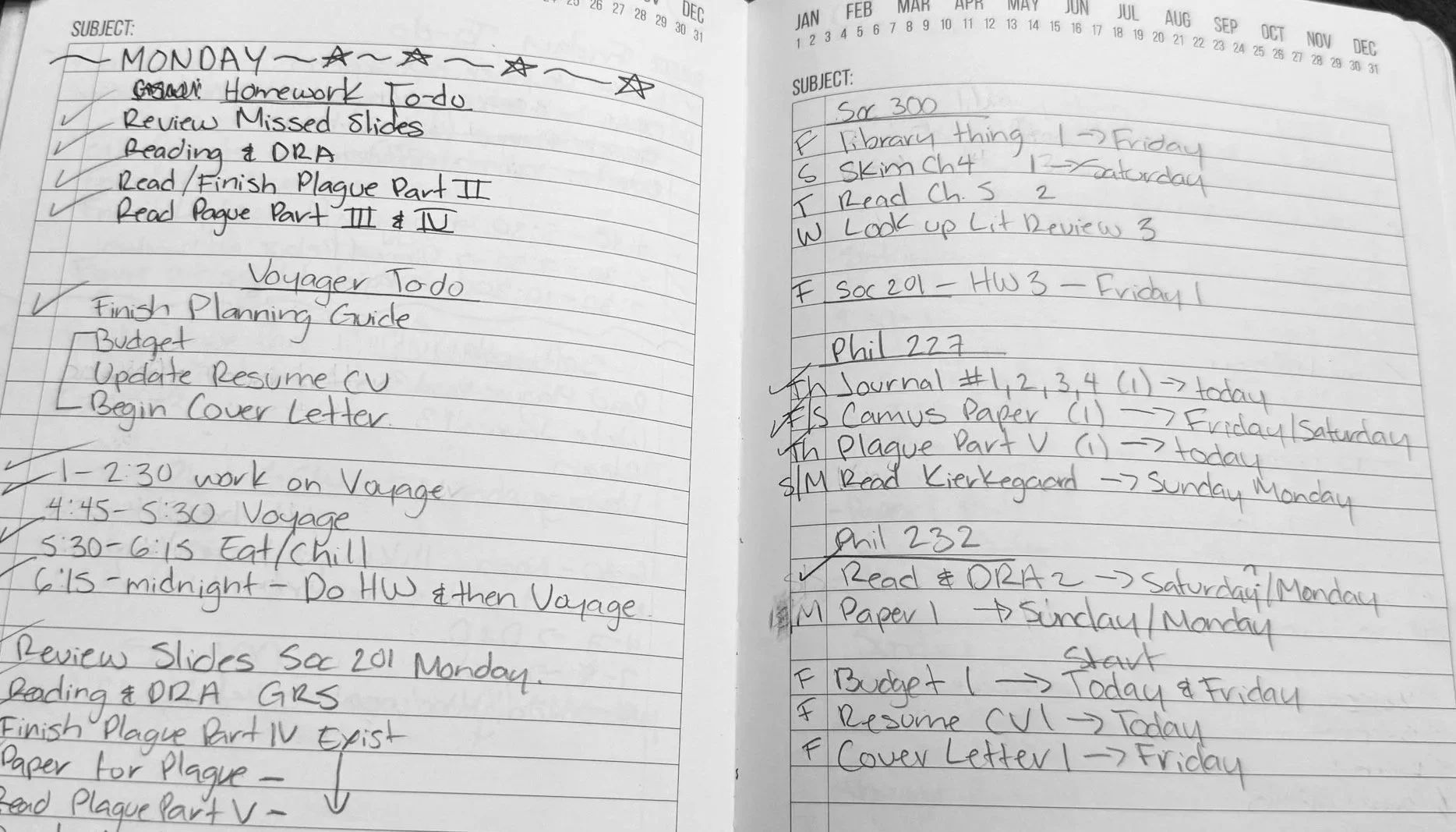
3
Take charge of your time.
One of the most common pieces of advice students had for each other? Get organized early. Whether you love Google Calendar, a paper planner, or something more visual, building a routine and protecting your time is a huge part of staying on track in college. But even before you do that, it’s important to really consider your priorities—what matters to you. How will you chose to invest your time to honor your values?
Skip to student videos.

“Time management is something you always have to be reworking…because it’s always changing. It’s really aligned with your priorities. Not everyone has the same priorities, so to expect everyone to have the same schedule and teach the same managing tips for everybody is insane. I had to learn that time management really depends on what I care about and what I love.”
—Selena
Why It Matters
Time management wasn’t just about remembering deadlines. Students who stayed organized said it helped them reduce stress, avoid burnout, and make space for real rest.
Part of it is about really thinking about your values and priorities and aligning your time to match those. Once you do that, though, staying organized is key.
No matter the method, everyone agreed: you need to find what works for you—and start using it right away.
Tools & Techniques Students Loved
Google Calendar
Most-used tool
Develop a color coding system that works for you
Enter assignments listed on the syllabus in Week 1 and then set reminders!
Paper Planners + To-Do Lists
Popular for students who like to write things down
Some used two: one for school, one for everything else
Time Blocking
Assigning blocks of time for studying, rest, classes, and big projects
Helps avoid procrastination and reduces anxiety
Students used both digital and paper formats to time block
Apps like Motion automate time-blocking by integrating your calendar and to-do list
Focus & Distraction Management
Opal: blocks distracting apps using your phone’s Screen Time settings
STEM Lab phone lockers: physical phone break
Pomodoro Method: 25 minutes of focus, 5-minute break
Focus Traveller: study companion app with a bear that climbs a mountain as you work
Try These Tips:
During the first week of class, go through each syllabus and put all major assignments and exams into your calendar or planner.
Research time blocking—and the Pomodoro Method. Might one of these be right for you?
Test out apps like Opal or Focus Traveller to reduce distractions while you work. Or, put your phone in one of the campus phone lockers.
Don’t over-schedule. Block time for breaks and downtime, too.
Find your preferred system (digital, paper, or a mix), and stick with it through the semester.
Want to share your system?
Do you color-code your calendar? Keep a beautiful bullet journal? Send us a photo of your planner or scheduling setup to inspire other students!
Or, tell us about how you prioritize your time based on your values.
Students explain their calendar systems
Yvette shows how she uses a paper schedule to keep her life organized.
Arlin shares her color-coding system in Google Calendar.
Got a favorite time organization technique, share it with us! We’d love to add it to this page!
Apps and strategies to help you focus
Precious loves Focus Traveler, an app where you can pick a “buddy” who climbs a mountain while you study. See your progress as you log more study hours.
This short video shows seven time-saving strategies, including Time Blocking, which Oscar and other students found really helpful.
Marnee loves using “Sessions” in her Opal app to create focused blocks of time where other apps are not available. Here’s the company explaining how it works.
Recommended YouTuber: Jim Kwik explains how he organizes his time.
The Pomodoro Technique is a popular focusing technique where you work for 25 minutes and then take a 5 minute break. Precious and other students love this.
Try any of these strategies out and tell us how it goes! Or, share different strategies with us to add to this page!
“Time management and organizational skills—you gotta develop that as soon as possible. That’s one of the very first things that I wish I had prioritized more my first semester.”
— Gabriela
“I block out my whole week and assign time to everything I need to do. It keeps me on track and helps me feel less anxious.”
— Cassandra
“I make time to study before or after class—once I leave campus, I know I’ll procrastinate.”
— Eric
Check out one of the other themes:
Find or Create Spaces Where You Can Focus
Select a Note-Taking Strategy That Works for You
Find and Use Campus Resources and Services
Stay Connected to Your “Big Why” (coming soon)